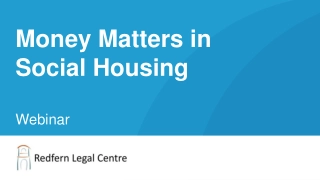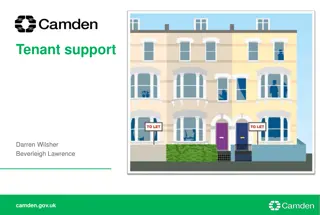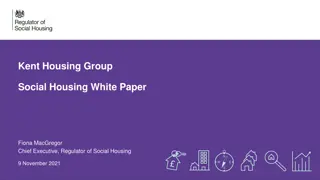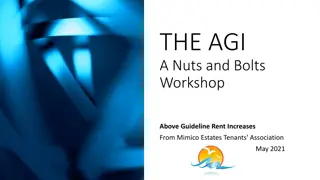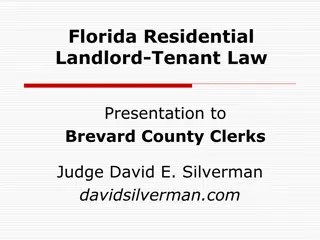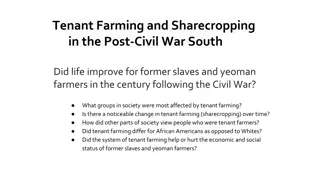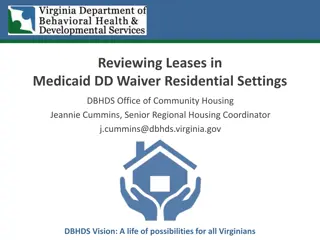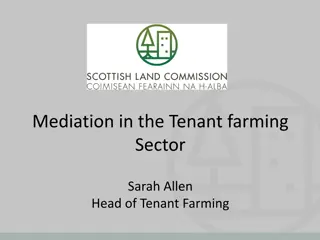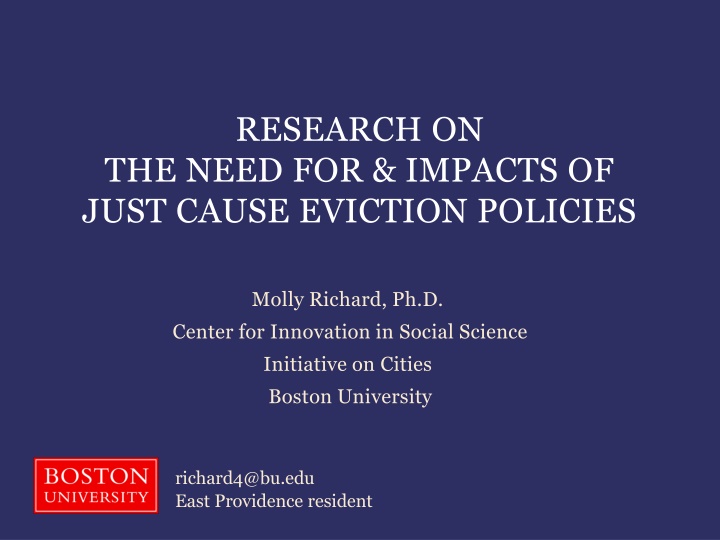
Addressing Housing Stability Through Just Cause Eviction Policies
Explore the impacts of just cause eviction policies on housing stability and homelessness. Learn how renter protections can help prevent homelessness, and discover the need for widespread adoption of such policies at the municipal and state levels.
Download Presentation

Please find below an Image/Link to download the presentation.
The content on the website is provided AS IS for your information and personal use only. It may not be sold, licensed, or shared on other websites without obtaining consent from the author. If you encounter any issues during the download, it is possible that the publisher has removed the file from their server.
You are allowed to download the files provided on this website for personal or commercial use, subject to the condition that they are used lawfully. All files are the property of their respective owners.
The content on the website is provided AS IS for your information and personal use only. It may not be sold, licensed, or shared on other websites without obtaining consent from the author.
E N D
Presentation Transcript
RESEARCH ON THE NEED FOR & IMPACTS OF JUST CAUSE EVICTION POLICIES Molly Richard, Ph.D. Center for Innovation in Social Science Initiative on Cities Boston University richard4@bu.edu East Providence resident
NATIONAL TRENDS IN INVESTOR- OWNED RENTAL HOUSING Lee, 2017 Seymour et al., 2013 Raymond et al., 2018 Leung et al., 2021 Gomory, 2022 Seymour & Akers, 2021 Reosti, et al., 2023 Gurun, et al., 2023 Growth in corporate & investor- owned rental housing Higher eviction rates More rapid rent increases & greater use of miscellaneous fees Less responsive Lower levels of property maintenance Decker, 2023 Goetz et al., 2024 Goetz & Damiano , 2025
INCREASED HOUSING INSECURITY & HOMELESSNESS Providence - the least affordable metro area in the United States (Redfin - Worley & Bokhari, 2025; based on the difference between median income required for rent and the median renter income) In the past 5 years, homelessness in RI has doubled. Jan. 2024 PIT Count: 2,442 people (HUD, 2024) The costs of not addressing this crisis are high: Individual Early mortality, increased injury, exacerbated poverty, poor educational outcomes for children, negative health outcomes across the lifespan (Garcia et al., 2024; Funk et al., 2022) Community High economic costs associated with homeless services, health care, criminal justice; working families feel the burden across communities (e.g., supporting doubled-up friends and family) (Keene & Blakenship, 2023)
HOMELESSNESS IS A HOUSING PROBLEM Decades of research shows a significant positive association between homelessness rates and median rent. (Honig & Filer, 1993; Lee et al., 2003; Quigley & Raphael, 2002; Byrne et al., 2013; Fargo et al., 2013; Hanratty et al., 2017; Glynn & Fox, 2019; GAO, 2020; Colburn & Aldern, 2022; Richard, in press). Adjusting for other factors - $100 increase in median rent is associated with: 9% increase in total homelessness (GAO, 2020) 27% increase in unsheltered homelessness (Richard, in press) Figure: Colburn & Aldern 2021 book: Homelessness is a Housing Problem
HOW CAN WE IMPROVE HOUSING STABILITY? In addition to preserving and producing affordable housing, communities can improve housing stability through renter protections (Merrit & Farnworth, 2021). Just Cause Eviction Protections help renters stay in their homes by preventing arbitrary, unfair, or retaliatory evictions.
WIDESPREAD ADOPTION OF JUST CAUSE Dozens of municipalities operate Just/Good cause along with other tenant protections such as rent stabilization. NJ, OR, CA, NH, WA state-level legislation Municipalities in NY and scattered across the country, including Philadelphia, St. Paul, and Washington DC (National Low Income Housing Coalition Tenant Protections Database, 2025)
IMPACT OF JUST CAUSE EVICTION PROTECTIONS Meets stated goals: Leads to decrease in eviction filings (Cuellar, 2019: Rate of Evictions before & after Good Cause Law Passed in California Cities) Is associated with lower rates of outmigration (Hwang et al., 2022) Has a direct and immediate impact on mitigating displacement (Chapple et al., 2023) Some argue that these protections discourage new housing construction. However, there is no published research to support this claim. In fact, evidence suggests otherwise.
IMPACT OF JUST CAUSE EVICTION PROTECTIONS A closer look at a working study of CA, OR, and NH (CA & OR enacted good cause in 2019; NH enacted in 2015) Pre- and post enactment of Just Cause In the absence of experimental design - Difference in differences model Comparison to similar jurisdictions without good cause A comparison of trends Data and analysis: County-level data on housing production Housing permit data (HUD) Controlling for income per capita, population, county-level GDP, unemployment, housing vacancy rate University of Minnesota Center for Urban and Regional Affairs & Loyola University Maryland Department of Economics: Shwartz, Goetz, Card & Davis, 2025
IMPACT OF JUST CAUSE EVICTION PROTECTIONS New Hampshire: Housing permits did not decline relative to the county-level trends in neighboring states that do not have just cause eviction protections (University of Minnesota and Loyola University Maryland, 2025 working paper - Shwartz, Goetz, Card & Davis)
IMPACT OF JUST CAUSE EVICTION PROTECTIONS CA and OR: Housing permits did not decline relative to the county-level trends in neighboring, matched counties in states that do not have just cause eviction protections Permitting in CA & OR actually increased relative to comparison counties, though not statistically significant (University of Minnesota and Loyola University Maryland, 2025 working paper - Shwartz, Goetz, Card & Davis)
(University of Minnesota and Loyola University Maryland, 2025 working paper - Shwartz, Goetz, Card & Davis)
IMPACT OF JUST CAUSE EVICTION PROTECTIONS In both analyses - no evidence that passage of Just Cause legislation at the state level led to a decline in housing production. The authors have gathered 54 endorsing academic peer signatories on letter reporting the emerging research and in support of the potential of Just Cause eviction legislation (including Harvard, Boston University, Rutgers, MIT, Tufts, UCLA) (University of Minnesota and Loyola University Maryland, 2025 working paper - Shwartz, Goetz, Card & Davis)
CONCLUSION Long-standing research shows that intervening in the housing market is necessary to address homelessness and housing insecurity. And is therefore key to preventing the individual, family, and community costs of these issues. Emerging research shows Just Cause protections can produce their intended effects Reducing evictions Stabilizing households in their apartments and neighborhoods Without leading to reduced rates of housing production.
REFERENCES Byrne, T., Munley, E. A., Fargo, J. D., Montgomery, A. E., & Culhane, D. P. (2013). New perspectives on community-level determinants of homelessness. Journal of Urban Affairs, 35(5), 607 625. Chapple, K., Loukaitou-Sideris, A., Miller, A., & Zeger, C. (2023). The role of local housing policies in preventing displacement: A literature review. Journal of Planning Literature, 38(2), 200-214.. Colburn, G., & Aldern, C. P. (2022). Homelessness is a housing problem. University of California Press. Cu llar, J. (2019). Effect of just cause eviction ordinances on eviction in four California cities. Journal of Public & International Affairs, 30, 4. Funk, A. M., Greene, R. N., Dill, K., & Valvassori, P. (2022). The impact of homelessness on mortality of individuals living in the United States: A systematic review of the literature. Journal of Health Care for the Poor and Underserved, 33(1), 457-477. Garcia, C., Doran, K., & Kushel, M. (2024). Homelessness and health: Factors, evidence, innovations that work, and policy recommendations: An overview of factors and policy recommendations pertaining to homelessness and health. Health Affairs, 43(2), 164-171. Hanratty, M. (2017). Do local economic conditions affect homelessness? Impact of area housing market factors, unemployment, and poverty on community homeless rates. Housing Policy Debate, 27(4), 640-655. Honig, M., & Filer, R. K. (1993). Causes of intercity variation in homelessness. The American Economic Review, 83(1), 248 255. Hwang, J., Zhang, I., Jeon, J. S., Chapple, K., Greenberg, J., & Shrimali, B. 2022. Research Brief: Who Benefits from Tenant Protections? The Effects of Rent Stabilization and Just Cause for Evictions on Residential Mobility in the Bay Area. https://static1.squarespace.com/static/5ebc6a5493ebe43c8bd9518e/t/622ff5be4c6e1e75933f7945/1647310272596/Brief_Who+Benefits+From+Tenant+Protections.pdf Keene, D. E., & Blankenship, K. M. (2023). The Affordable Rental Housing Crisis and Population Health Equity: A Multidimensional and Multilevel Framework. Journal of Urban Health, 100(6), 1212 1223. Lee, B. A., Price-Spratlen, T., & Kanan, J. W. (2003). Determinants of homelessness in metropolitan areas. Journal of Urban Affairs, 25(3), 335 356. Merritt, B., & Farnworth, M. D. (2020). State Landlord Tenant Policy and Eviction Rates in Majority-Minority Neighborhoods. Housing Policy Debate, 31(3 5), 562 581 National Low Income Housing Coalition. (Updated 2025). State and Local Tenant Protections Database. https://nlihc.org/tenant-protections National U.S. Dept of Housing and Urban Development. (2024, Dec). HUD 2024 Continuum of Care Homeless Assistance Programs Homeless Populations and Subpopulations. https://files.hudexchange.info/reports/published/CoC_PopSub_CoC_RI-500-2024_RI_2024.pd Quigley, J. M., & Raphael, S. (2002). The Economics of Homelessness: The evidence from North America. European Journal of Housing Policy, 1(3), 323 336. Richard, M. K. (In press). Homelessness and race: The impact of structural conditions on Back, White, and Latine homelessness. Accepted for publication in Social Problems Shwartz, J., Goetz, E., Card, K., Davis, E. (2025 working paper) University of Minnesota Center for Urban and Regional Affairs, Loyaola University Maryland. Worley, M. & Bokhari, S. Renters Need to Earn $63,680 to Afford the Typical U.S. Apartment the Lowest Amount in 3 Years. Redfin News. https://www.redfin.com/news/rent-affordability-2025/


